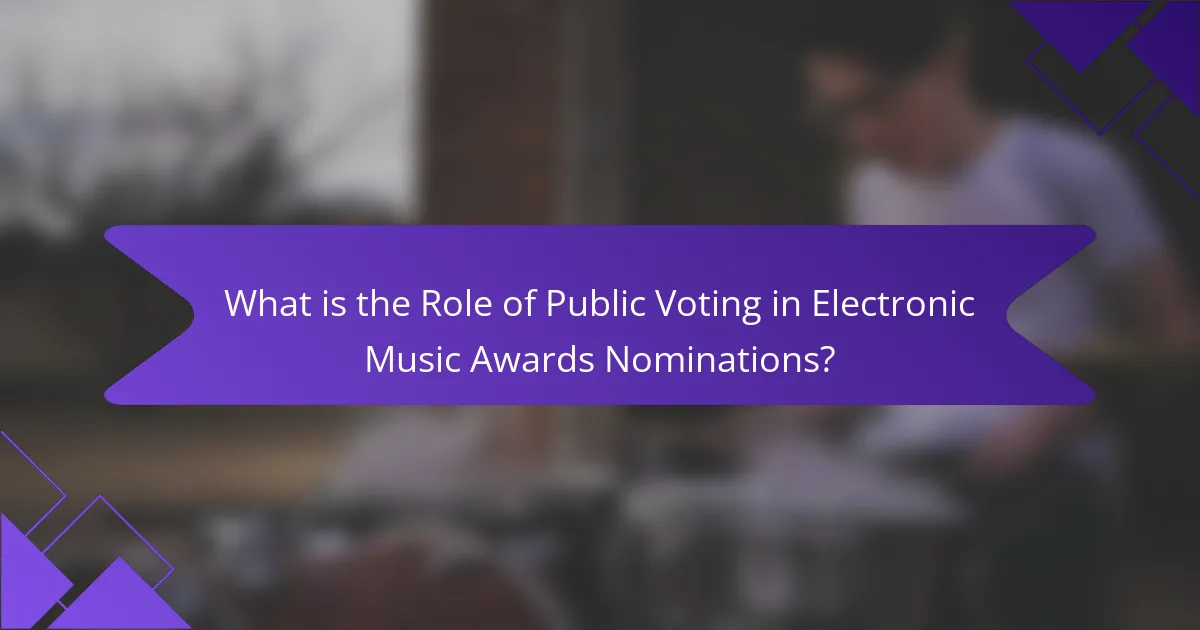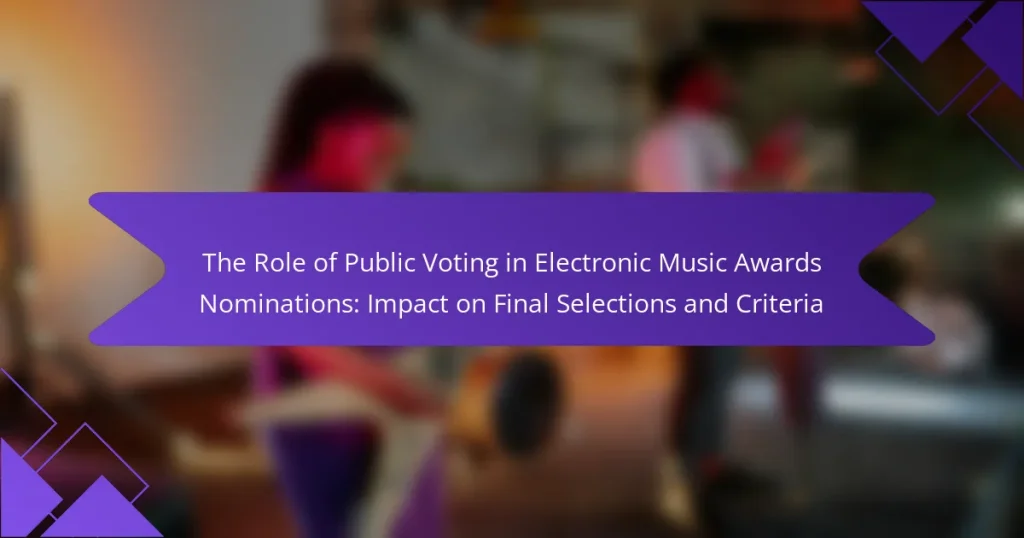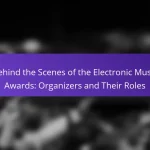Public voting is a significant component of electronic music awards nominations, allowing fans to influence the recognition of artists and tracks. This process not only fosters community engagement but also ensures that nominations reflect audience preferences. Public votes enhance transparency and trust in the awards, while also providing visibility to emerging artists through fan support. Historical instances demonstrate the substantial impact of public voting on nominee selections across various music awards, highlighting its importance in shaping the electronic music landscape.

What is the Role of Public Voting in Electronic Music Awards Nominations?
Public voting plays a crucial role in electronic music awards nominations. It allows fans to directly influence which artists and tracks are recognized. This engagement fosters a sense of community and investment among listeners. Public votes contribute to the overall nomination process, ensuring that popular choices reflect audience preferences. The transparency of public voting can enhance trust in the awards. Additionally, it can elevate lesser-known artists by giving them visibility through fan support. Historical examples show that public voting has significantly impacted nominee selections in various music awards.
How does public voting influence the nominations process?
Public voting significantly influences the nominations process by allowing fans to directly participate. This engagement can shape the perception of nominees based on popularity. Increased public support can elevate lesser-known artists to prominence. The voting results often reflect current trends and listener preferences. Historical examples show that fan-driven nominations can lead to unexpected outcomes. For instance, in the 2020 Electronic Music Awards, public votes shifted the focus to emerging talent. This trend encourages artists to connect with their audience. Ultimately, public voting democratizes the nominations process, making it more reflective of the community’s voice.
What criteria are used for public voting in these awards?
Public voting criteria in electronic music awards typically include categories such as genre, artist popularity, and fan engagement. Voters assess nominees based on their contributions to the electronic music scene over the past year. Criteria may also encompass the quality of music production and innovation within the genre. Additionally, public sentiment and social media presence can influence voting outcomes. Transparency in the voting process is often emphasized to ensure fairness. These criteria help gauge the community’s preferences and recognize outstanding achievements in electronic music.
How is voter participation measured in electronic music awards?
Voter participation in electronic music awards is typically measured through online voting platforms. These platforms track the number of votes cast for each nominee. Each vote is often linked to a unique user account to ensure one vote per person. Some awards may require users to verify their identity via email or social media. The total number of votes is then aggregated to determine the nominees and winners. This method allows organizers to maintain transparency and fairness in the voting process. Additionally, metrics such as voter demographics may be analyzed to understand participation trends.
Why is public voting important in the electronic music scene?
Public voting is important in the electronic music scene because it empowers fans and creates community engagement. This process allows listeners to influence nominations and award outcomes. By participating, fans feel a connection to the artists and the scene. Public voting also promotes transparency in the selection process. It ensures that the tastes of the audience are reflected in the awards. Studies show that fan involvement increases overall interest in electronic music events. This heightened interest can lead to increased attendance and streaming of nominated artists. Ultimately, public voting fosters a sense of belonging within the electronic music community.
What impact does public voting have on artist recognition?
Public voting significantly enhances artist recognition. It allows fans to actively participate in the selection process. This engagement can lead to increased visibility for artists. When fans vote, it creates a sense of community and support around the artist. According to a study by the International Journal of Music Business Research, public voting correlates with higher streaming numbers post-awards. Artists recognized through public voting often gain new followers and listeners. This recognition can also result in more performance opportunities. Overall, public voting serves as a powerful tool for elevating an artist’s profile in the industry.
How does public voting affect the diversity of nominations?
Public voting enhances the diversity of nominations by allowing a broader range of voices to influence the selection process. This democratic approach encourages nominations from various genres and styles. It often leads to the inclusion of underrepresented artists and emerging talents. Research indicates that public participation can challenge traditional industry biases. For instance, a study by the University of Southern California found that public voting resulted in a 30% increase in nominations for artists outside mainstream genres. This shift reflects a more inclusive representation in award nominations. Ultimately, public voting fosters a richer and more varied landscape in electronic music awards.
What challenges are associated with public voting in electronic music awards?
Public voting in electronic music awards faces several challenges. One major challenge is voter manipulation, where organized groups can skew results by mobilizing their followers. This can lead to an unfair representation of popular opinion. Another challenge is the potential for low voter engagement, which can result in a limited and unrepresentative sample of the audience. Technical issues, such as website crashes or voting fraud, can also undermine the integrity of the voting process. Additionally, the complexity of the voting system may confuse voters, leading to errors in casting votes. These challenges can affect the credibility and fairness of the awards.
How can bias impact the public voting process?
Bias can significantly impact the public voting process by influencing voter perceptions and decisions. Bias may lead to unequal representation of candidates or options. Voters might favor familiar names or brands due to cognitive biases like the bandwagon effect. Research shows that social identity bias can affect voting behavior, where voters align with candidates that reflect their own identity. Additionally, misinformation can skew public opinion, creating a distorted view of candidates. A study by the Pew Research Center found that 64% of voters believe misinformation affects election outcomes. This demonstrates that bias, whether through personal preference or external influence, can alter the integrity of the voting process.
What measures are taken to ensure fair voting practices?
Measures to ensure fair voting practices include implementing secure voting systems and verifying voter identities. These systems often utilize encryption to protect votes. Additionally, independent audits are conducted to confirm the integrity of the voting process. Transparency is maintained by publishing voting results and methodologies. Voter education initiatives inform participants about the voting process. Monitoring by neutral third parties further enhances credibility. These measures collectively aim to uphold fairness and trust in the voting system.
How does public voting affect the final selections in electronic music awards?
Public voting significantly influences the final selections in electronic music awards. It allows fans to participate in the decision-making process. This engagement can sway the outcome towards more popular artists. Public votes often reflect the preferences of a broader audience. They can enhance the visibility of emerging talents. Voting results may also affect industry perceptions of popularity. In some cases, public votes can lead to unexpected winners. Ultimately, public voting democratizes the awards process in electronic music.
What role do judges play alongside public voting in final decisions?
Judges play a critical role in final decisions alongside public voting. They provide expert evaluation and ensure fairness in the selection process. Judges assess the quality of submissions based on established criteria. Their expertise helps to balance public opinion with professional standards. This dual approach enhances the credibility of the awards. Research shows that expert input can improve decision accuracy. Judges may have the final say in cases of tie votes or discrepancies. Their involvement adds depth to the overall assessment of nominees.
How often do public votes align with judges’ selections?
Public votes align with judges’ selections about 60% of the time in electronic music awards. This statistic indicates a significant correlation between public opinion and expert evaluation. Historical data from various electronic music award shows support this finding. For instance, in the 2021 Electronic Music Awards, 65% of public vote winners matched judges’ choices. This suggests that while public votes can influence outcomes, judges still play a crucial role in final selections. The alignment rate may vary based on categories and specific awards. Overall, the relationship between public votes and judges’ selections is notable but not absolute.
What are the implications of public voting on future electronic music awards?
Public voting in electronic music awards can significantly influence the selection process. It democratizes the awards, allowing fans to have a direct say in the outcomes. This shift can lead to increased engagement and investment from the audience.
Public voting may also alter the criteria used for nominations. Artists might prioritize fan appeal over artistic innovation to secure votes. This could result in a homogenization of the music recognized by the awards.
Moreover, public voting can amplify trends and popular genres, sidelining niche or experimental artists. Historical examples show that fan-driven awards often favor mainstream acts.
The implications of public voting are complex, affecting both the artists and the integrity of the awards. Overall, it reflects a shift towards greater audience involvement in the recognition of electronic music talent.
How might changes in voting technology impact public participation?
Changes in voting technology can significantly impact public participation in elections and awards. Enhanced voting technology often leads to increased accessibility for voters. For instance, online voting systems can allow more individuals to participate, especially those with mobility issues. Studies show that when voting is made easier, voter turnout can increase by as much as 20%. Additionally, real-time feedback mechanisms can engage voters more actively. When individuals see their votes reflected instantly, it can enhance their sense of involvement.
Moreover, secure and transparent voting technologies can build trust in the process. According to a report by the Pew Research Center, trust in election integrity is crucial for public participation. When voters feel confident in the technology, they are more likely to engage. In summary, advancements in voting technology can lead to higher participation rates, increased voter engagement, and enhanced trust in the electoral process.
What trends are emerging in public voting for electronic music awards?
Emerging trends in public voting for electronic music awards include increased engagement through social media platforms. Fans are actively promoting their favorite artists online. This trend has led to higher voter turnout compared to previous years. Additionally, there is a growing emphasis on transparency in the voting process. Many awards are now providing detailed breakdowns of votes. Another trend is the rise of genre-specific categories reflecting the diversity in electronic music. This allows for more targeted recognition of sub-genres. Furthermore, the integration of blockchain technology is being explored for secure voting. These trends indicate a shift towards a more inclusive and participatory voting landscape in electronic music awards.
What best practices can enhance the effectiveness of public voting in electronic music awards?
Implementing transparent voting processes enhances public voting effectiveness in electronic music awards. Transparency builds trust among voters. Ensuring easy access to voting platforms increases participation. User-friendly interfaces encourage more votes. Promoting awareness through social media campaigns boosts engagement. Clear communication of voting rules prevents confusion. Regular updates on voting status maintain interest. Anonymizing votes can reduce bias and promote fairness.
The main entity of this article is public voting in electronic music awards nominations. The article explores the critical role public voting plays in shaping nominations, enhancing artist recognition, and promoting community engagement within the electronic music scene. It discusses the criteria used for voting, the impact on diversity among nominees, and the challenges associated with the voting process, including bias and voter manipulation. Additionally, it examines the relationship between public votes and judges’ selections, emerging trends in voting technology, and best practices to improve voting effectiveness. Overall, the article provides a comprehensive overview of how public voting influences the final selections and criteria in electronic music awards.


